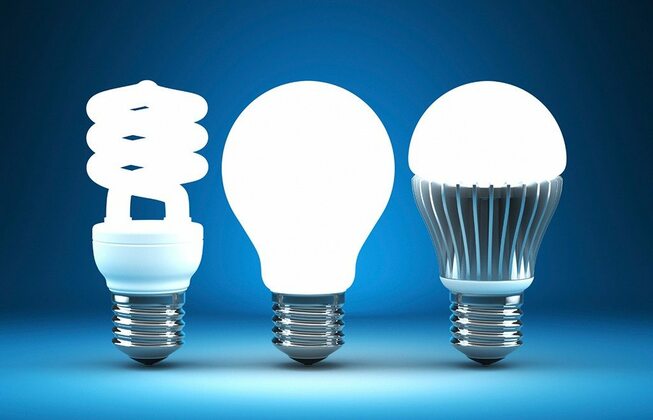Welcome to the topic Reasons to convert incandescent bulbs to LEDs.
What exactly is an incandescent light?
The incandescent light bulb is the most common type of light bulb. It generates light by heating a wire filament to a temperature that causes light to be produced. A translucent glass bulb, either filled with inert gas or evacuated, surrounds the metal wire (a vacuum).
What are the major flaws of incandescent lighting?
The following are some of the shortcomings of incandescent lighting:
The energy efficiency of incandescent lights is the lowest on the market. Incandescent lamps have efficiency ratings of about 10 lumens per watt. Unfortunately, the majority of the energy they consume (90 percent) is used to generate heat.
Incandescent lights have the shortest lifespan available. The average bulb has a lifespan of roughly 1,200 hours. This means that, while incandescent bulbs are inexpensive, you’d have to buy a lot of them (50-100) to equal the lifespan of a single LED. Overall, this translates to significant maintenance expenditures.
What are the Minor Flaws of Incandescent Lights?
The following are some of the minor flaws in incandescent lighting:
Light from incandescent bulbs is omnidirectional. Omnidirectional lights emit light in all directions. This is a significant inefficiency in the system because at least half of the light must be reflected and redirected to the intended area to be lighted. Because of the necessity for light reflection and redirection, the output of omnidirectional lights is substantially less efficient due to losses than it would be for the same light if it were directional by nature.
A Light Emitting Diode (LED) is a semiconductor that emits light.
LED is an abbreviation for light-emitting diode. A diode is an electrical device or component that consists of two electrodes (an anode and a cathode) through which electricity flows – often in only one direction (in through the anode and out through the cathode).
Diodes are often made of semi-conductive materials such as silicon or selenium – solid-state compounds that conduct electricity under certain conditions but not others (e.g., at specific voltages, current levels, or light intensities). The device emits visible light when current flows through the semiconductor material. It is the opposite of a photovoltaic cell (a device that transforms sunlight into electricity).
LEDs have a substantially longer lifespan than other types of light bulbs. Fewer light bulbs mean less waste, which helps to protect our environment and landfills.
LED (light-emitting diode) lighting is the way to go when lighting a home or even a large business facility. It uses less energy and lasts longer than older incandescent, fluorescent, or other types of lighting.
We have developed a list of the following reasons why you should switch to LED lighting:
- SAVINGS ON ENERGY
The most apparent reason for LED conversion is to save energy. LED lights to use at least 75% less energy than incandescent bulbs, particularly those with ENERGY STAR ratings. This will save you a lot of money on electricity use over time.
- LENGTH OF LIFE
Simply put, LED bulbs to have a far longer lifespan than fluorescent and incandescent lamps. According to statistics, an average LED light lasts 25 times longer than incandescent illumination.
- TECHNOLOGY-LED
Technology LED lights are more energy-efficient than incandescent lamps. They radiate light in only one direction, eliminating the need for reflectors and diffusers. LEDs are ideal for recessed downlights and task lighting.
- SAFETY LED
Safety LED lights are proven to produce far less heat. This makes them less likely to burn out and less likely to create harm or a fire hazard in their surroundings.
- FLEXIBILITY
LED lighting solutions for household, industrial, and commercial applications are widely available on the market. Whatever type of illumination you require, LED versions are available for energy savings and durability.
- SIGNIFICANTLY BETTER LIGHTING
Another noteworthy advantage of LED lighting is that it creates a more pleasant environment. When compared to fluorescent lighting, the light is less harsh. There is rarely any kind of “hum” that will drive you insane.
- LESS TIME DOWN
When your bulbs live longer, you will have less downtime and require less maintenance. This saves you time, effort, and money.
- REBATE ON UTILITIES
If you convert your commercial space to LED lighting, your organization may be eligible for government or utility company subsidies. American Electric can inform you of any utility rebates available in your region.
These are just a handful of the numerous advantages of LED lighting. Contact American Electric today to learn more about LED conversion. We will assist you in making the most of your commercial or domestic lighting requirements.
Where Is LED Used Most Commonly?
LEDs were first used in practical applications in computer circuit boards. Since then, their applications have gradually grown to encompass traffic lights, illuminated signs, and, more recently, indoor and outdoor illumination. LED lighting is an excellent choice for gymnasiums, warehouses, schools, and commercial facilities.
They are also suitable for prominent public places (which necessitate bright, efficient illumination over a wide area), road lighting (which provides considerable color advantages over low and high-pressure sodium lights), and parking lots.
Why might LEDs prevent the need for incandescent bulbs?
Incandescent bulbs use a lot of energy and are pretty inefficient. They only convert around one-twentieth of the energy they use into visible light. The vast bulk (about 90%) of the energy is wasted as heat.
All of this adds up to money. Although they have a cheap initial cost, incandescent bulbs will cost you money in the long run due to the inefficient way they perform and the frequency with which they must be replaced. This inefficiency will quickly add up in a large-scale building (such as a school, hospital, or commercial building).
Have any questions regarding the topic Reasons to convert incandescent bulbs to LEDs? Feel Free to comment below.
Also Read: Tesla Car Charger Install in Athens




